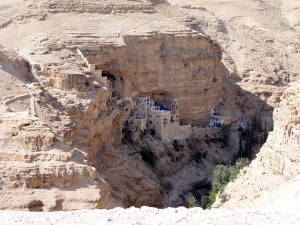 Judean Monastery
Judean Monastery
OK, so I was wrong. When I first explored the history of Christian spirituality, I learned that there were two forms of monasticism in the fourth century: anchorites and cenobites. Anchorites were those, like Antony, who went away far into the desert and lived alone. Cenobites were those, like Pachomius, who founded communities of monks. And that’s what I told others. Later I learned about “sketes” or lavra, small collections of hermitages built around a central meeting hall. But recently I have discovered just how rich the breadth of expression was in early monastic life. So much so that I feel obliged to repent of my former statements. So here’s my current list of forms of “monastic life”: Anchorite Antony and cenobite Pachomius learned their practice from village monks, holy men who lived on the edge of town. In addition to the sketes of Egypt and the lavra of Palestine, there were also places like Nitria and Oxyrhynchus, desert cities with clerical or monastic leadership and strong links to the larger world. There were those who devoted themselves to prayer and ascetical practice in the context of ordinary domestic life. There were household monastic communities, formed on the estate of a particular family and which included many family members, slaves, and other friends. Around AD 340, Marcella of Monastic headquarters today?
 Rome founded an urban monastic collective in a group of neighboring homes. There were traveling monks who, like Jesus, never had a place to lay their heads. There were those who took the practice of compassionate care as a life of devotion to God. Some people in Syria formed special societies of members within their local congregations of people devoted to God in monastic-style ways. Now I understand: the ways of expressing whole-hearted devotion to God and kingdom living are limited only by the bounds of our own creativity.
Rome founded an urban monastic collective in a group of neighboring homes. There were traveling monks who, like Jesus, never had a place to lay their heads. There were those who took the practice of compassionate care as a life of devotion to God. Some people in Syria formed special societies of members within their local congregations of people devoted to God in monastic-style ways. Now I understand: the ways of expressing whole-hearted devotion to God and kingdom living are limited only by the bounds of our own creativity.
